5 Fruits That Are Good for Diabetes
Medically reviewed by Kelly Wood, MD
When you have diabetes, following a healthful diet is essential. A well-balanced eating pattern can help you control blood sugar and reduce the risk of developing other health conditions associated with diabetes, such as heart disease and high blood pressure.
Fresh fruit can be part of a nutritious, diabetes-friendly diet. But due to misinformation out there, some people with diabetes think they have to avoid fruit because most fruits are high in carbs and natural sugars. However, recent research shows that people with diabetes can regularly enjoy fruit and that doing so can even help decrease blood sugar levels. This means improved control over your diabetes.
While most people with diabetes can eat any fresh fruits, there are a few fruits that stand out due to their impressive nutrition profile and impact on blood sugar. Here are five of the best fruits for diabetes.
1. Berries
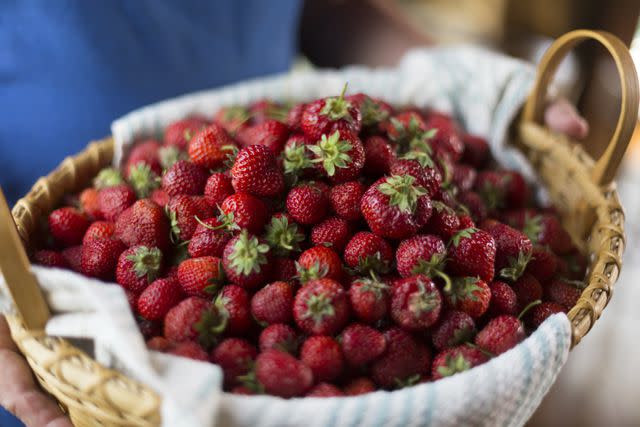
Getty Images / Jon Lovette
Berries, such as blueberries, raspberries, and blackberries, are among the most nutritious fruits you can eat. Not only are they rich in fiber, vitamins, minerals, antioxidants and compounds with anti-inflammatory effects, but research has also linked berry consumption with improved glycemic control.
For example, a 2020 review found that eating berries may help reduce post-meal insulin and blood sugar levels, which can benefit people with diabetes.
A 2022 review that included 22 studies found that the consumption of blueberries and cranberries significantly reduced fasting blood sugar and the long-term blood sugar control marker hemoglobin A1c (HbA1c) among people with diabetes.
Berries have this positive effect on diabetes partly because they are rich in fiber, which helps slow the absorption of sugar into the bloodstream. They’re also high in antioxidants and anti-inflammatory compounds, like flavonoids, which could also help promote healthy blood sugar and insulin levels due to the substances' anti-diabetic properties.
Adding berries to your diet could even help lower your risk of developing diabetes in the first place. Research has associated regular intake of berries with a lower risk of types 2 diabetes as well as conditions like heart disease, hypertension, and certain cancers.
2. Avocados
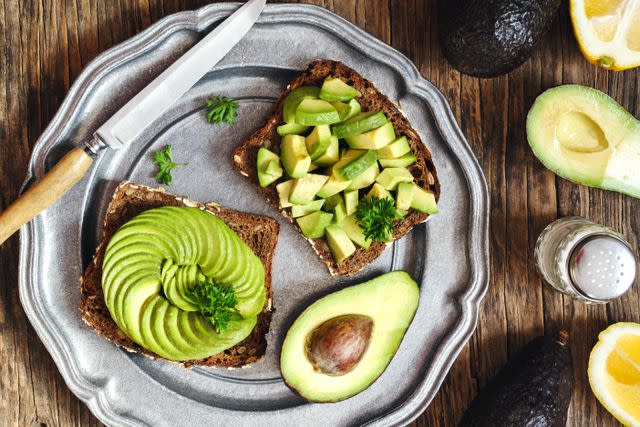
Getty Images / AnjelikaGretskaia
Avocados are a unique fruit as they’re low in carbs and high in fat. A half of an avocado contains just 8.5 grams of carbs and provides nearly 30 grams of healthy fats, making avocados a smart fruit choice for those on lower-carb diets. Avocados are especially high in monounsaturated fats, which have been shown to benefit people with diabetes. A 2016 review of 24 studies demonstrated that diets high in monounsaturated fats were associated with better glycemic control in people with type 2 diabetes compared to diets high in carbs or polyunsaturated fats.
Avocados are also rich in fiber, which can blunt post-meal blood sugar spikes. High-fiber diets are a good choice for people with type 2 diabetes, as diets rich in fiber have been linked to improvements in glycemic control, body weight, blood lipid levels, and markers of inflammation in people with type 2 diabetes.
When it comes to research on avocados specifically, eating the fruit has been shown to help promote healthy blood sugar and insulin levels. However, it’s important to note that many studies investigating the health effects of avocados, including their impact on blood sugar levels, were funded by the Hass Avocado Board, which works to promote the popularity of avocados.
3. Citrus Fruits
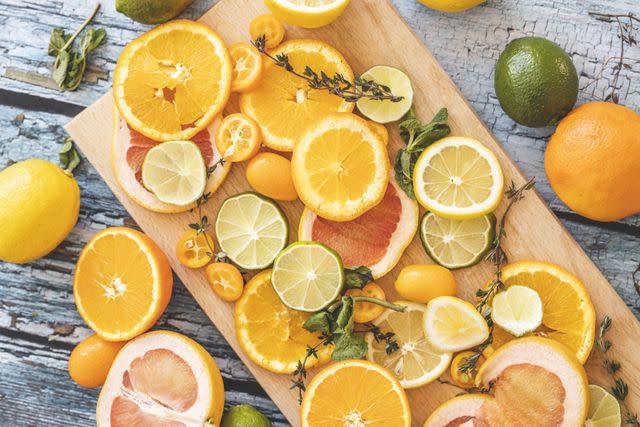
Getty Images / Eleganza
Citrus fruits, such as oranges and grapefruit, are a good choice for people with diabetes. Not only do the fruits have a low glycemic index (GI)—a measure of how slowly or quickly a food spikes blood sugar levels—but they’re also packed with nutrients that can help reduce inflammation and support healthy glycemic control.
Oranges have a GI of 43, which is considered low. This means that oranges will have less of an impact on your blood sugar compared to high-GI fruits, such as watermelon.
Older research suggests that regularly consuming low-GI fruit could help people with diabetes lower their HbA1c, blood pressure, and heart disease risk.
Citrus fruits are also high in antioxidant plant compounds, including naringenin, a type of polyphenol that has powerful anti-diabetic properties.
4. Apples
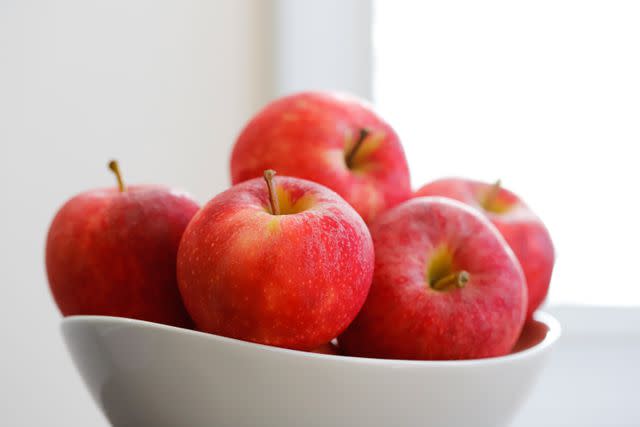
Getty Images / Daniela Duncan
Apples are another low-GI fruit that are rich in nutrients important for diabetes control. A medium-sized apple provides around 5 grams of fiber, including soluble fiber, which delays the absorption of sugar into the bloodstream.
Choosing foods rich in soluble fiber can help promote healthy blood sugar and blood lipid levels, which is important for people with type 2 diabetes.
Studies show that eating apples may benefit people with impaired blood sugar control. In a 2022 study, eating an apple before a meal of rice significantly reduced post-meal blood sugar in people with impaired glucose tolerance compared to when they ate the rice meal before the apple. The researchers suggested that the soluble fiber, as well as other anti-diabetic compounds found in apples, may benefit people with high blood sugar levels, such as those with type 2 diabetes.
5. Pomegranates
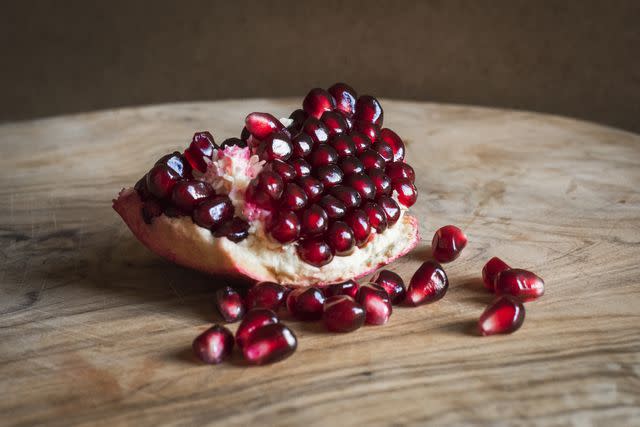
Getty Images / Irena Sowinska
Pomegranate intake has been associated with a number of health benefits, including reducing blood pressure, blood sugar, and cholesterol levels and improving insulin resistance. Pomegranate arils, or seeds, and pomegranate juice are excellent sources of bioactive compounds such as ellagitannins, anthocyanins, and organic acids, which can help reduce inflammation and protect against cellular damage.
Research shows that consuming pomegranate products may specifically benefit the health of people with type 2 diabetes. For example, a 2019 study found that drinking 200 milliliters of pomegranate juice per day for six weeks resulted in significant reductions of both systolic and diastolic blood pressure levels in people with type 2 diabetes compared to a control group.
People with type 2 diabetes are at an increased risk for high blood pressure (hypertension), so maintaining healthy blood pressure levels by consuming foods that have antihypertensive properties is an easy and effective way to care for your health.
Pomegranate arils can also help support healthy blood sugar levels. The seeds may be an even better choice for those with type 2 diabetes as they’re rich in fiber, which can help slow sugar absorption into the bloodstream. Although pomegranate juice can be enjoyed by people with diabetes, it’s wise to consume pomegranate juice in small amounts with a mixed meal containing fiber and protein to promote optimal blood sugar regulation.
Fruits to Avoid
Most people with type 2 diabetes don’t have to avoid fresh fruit. Fresh fruits, such as berries, cherries, citrus fruits, and peaches can be enjoyed as part of a healthy, well-rounded diabetes-friendly diet.
That said, there are certain fruit products that should be limited—whether you have diabetes or not. The following fruit products could contribute to poor blood sugar control and may negatively impact health if eaten too often:
Sugar-coated dried fruit: Unsweetened dried fruit can be a healthy choice when eaten in small portions and consumed alongside protein-rich foods, like nuts. However, sweetened dried fruit can be high in added sugar. For instance, sweetened dried pineapple can contain as much as 47.5 grams of added sugar per 100-gram serving, which equates to nearly 12 teaspoons. Consuming too much added sugar can negatively impact your blood sugar control and lead to the development of other health issues, such as fatty liver and heart disease.
Canned fruit in syrup: Just like sweetened dried fruit, canned fruit in syrup can be shockingly high in added sugar. For example, a cup of fruit cocktail in heavy syrup contains around 6.5 teaspoons of added sugar.
Fruit-based desserts: Sugary fruit-based desserts, such as sorbet and fruit pops, are typically high in added sugar and total carbohydrates and should be limited for optimal blood sugar control.
Sweetened fruit juices: It’s fine to enjoy small amounts of 100% fruit juice from time to time. But drinking beverages high in added sugar and total carbohydrates, such as sweetened fruit juice products, too often could negatively impact your blood sugar control and overall health.
How Much Fruit Should You Eat?
The 2020–2025 Dietary Guidelines for Americans recommend that adults eat 1.5–2 cups of fruit a day. If you have diabetes, a healthcare provider can help you develop an eating plan that works best for your needs—maybe suggesting the optimal amount of fruit for you or which fruits would benefit you most.
But know that just because you have diabetes doesn't mean you should avoid consuming fresh fruit. Just the opposite, actually. Research shows that eating fruit can help reduce the risk of diabetes complications and mortality and improve glycemic control in people with type 2 diabetes.
A 2019 Chinese study that included data on 19,473 people with type 2 diabetes found that levels of fasting blood sugar and HbA1c decreased as the frequency and amount of fresh fruit consumption increased. The study also found that, compared with the participants who did not eat fresh fruit, the participants who consumed fresh fruit five or more times per week had a 30% lower risk of poor glycemic control.
How to Choose Fruits
When shopping for fruit, it's best to stick with fresh fruit, including the five fruits listed above.
There are tons of fruit out there, though. Which fruits you pick might depend on your personal taste preferences. Your specific dietary needs might also play a factor. For instance, if searching for foods with a low glycemic index is important to you, you might want to consider the GI of the fruit.
The GI scale goes from 0 to 100. The lower the number, the slower the food increases your blood glucose. The higher the number, the quicker the food can increase your blood glucose. Most fruits are considered low-GI foods, meaning they are between 0-55 on the GI scale.
Some fresh fruits, like melons and pineapple, have medium GI values. This means they have a GI between 56-69. If you prefer dried fruits like dates, raisins, and sweetened cranberries, know that they have medium GI values, too.
The GI score of a fruit might also change depending on how ripe the fruit is. Fruits have a higher starch content in their earlier stages. The higher starch content means it will take you longer to digest the food. As the fruit continues to ripen, the starch turns into simple sugars, increasing the fruit's GI. For instance, green bananas—less ripe, higher starch content—were shown to have less of an effect on glucose compared to ripe bananas.
You can talk with a healthcare provider about whether you need to consider the GI of a fruit when choosing which to eat. Maybe there are other factors you need to think about, like the amount of carbs. Or, maybe instead of focusing on the specific fruit, the provider will instead offer tips on what else to eat with the fruit to make it a well-balanced meal or snack.
For instance, pairing fruit with protein-rich foods such as nuts or hard-boiled eggs can help you maintain optimal blood sugar control since protein helps slow digestion, thus preventing post-meal blood sugar spikes. For example, pair a piece of fresh fruit, such as an apple, with a small handful of almonds for a filling snack that's blood sugar-friendly.
A Quick Review
Most people with diabetes can regularly enjoy fresh fruit without negatively impacting their blood sugar levels. Although all fresh fruits make a healthy choice, certain fruits, like berries, avocados, citrus fruits, apples, and pomegranates, may offer specific health benefits for people with type 2 diabetes, such as improving post-meal blood sugar levels and lowering blood pressure. If you have questions about including fruit as part of a diabetes-friendly diet, speak with a healthcare provider for individualized dietary advice.
For more Health.com news, make sure to sign up for our newsletter!
Read the original article on Health.com.

